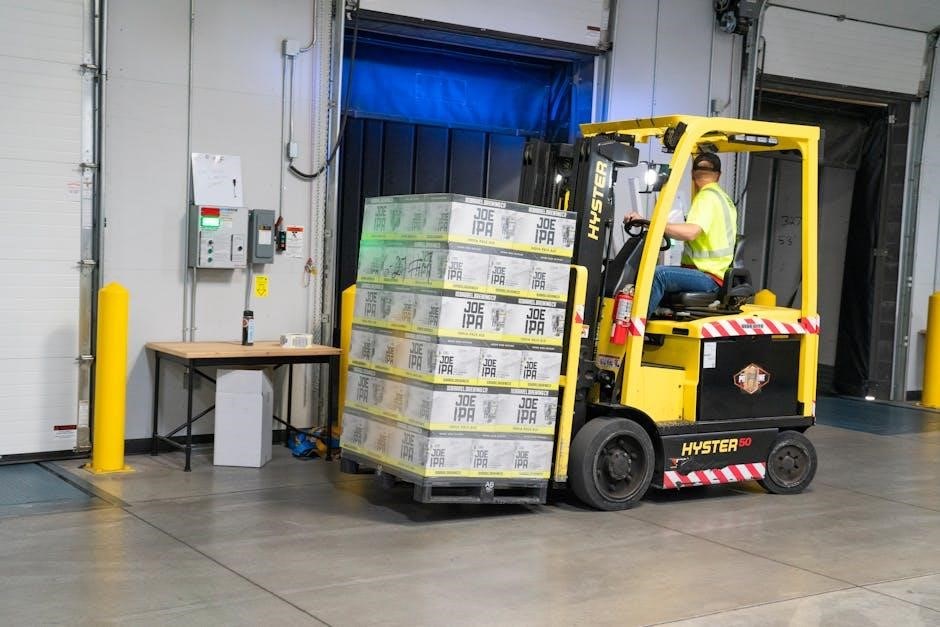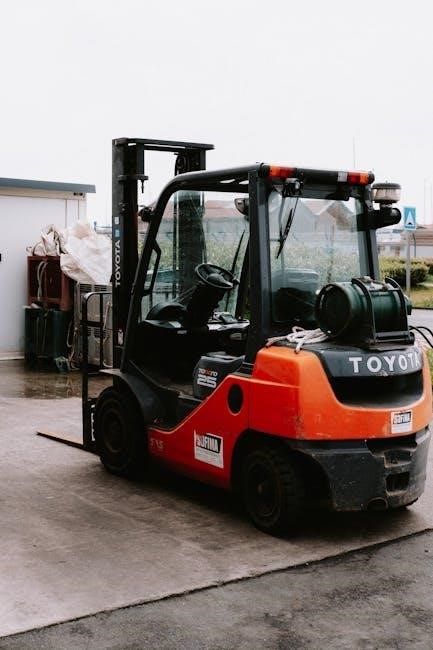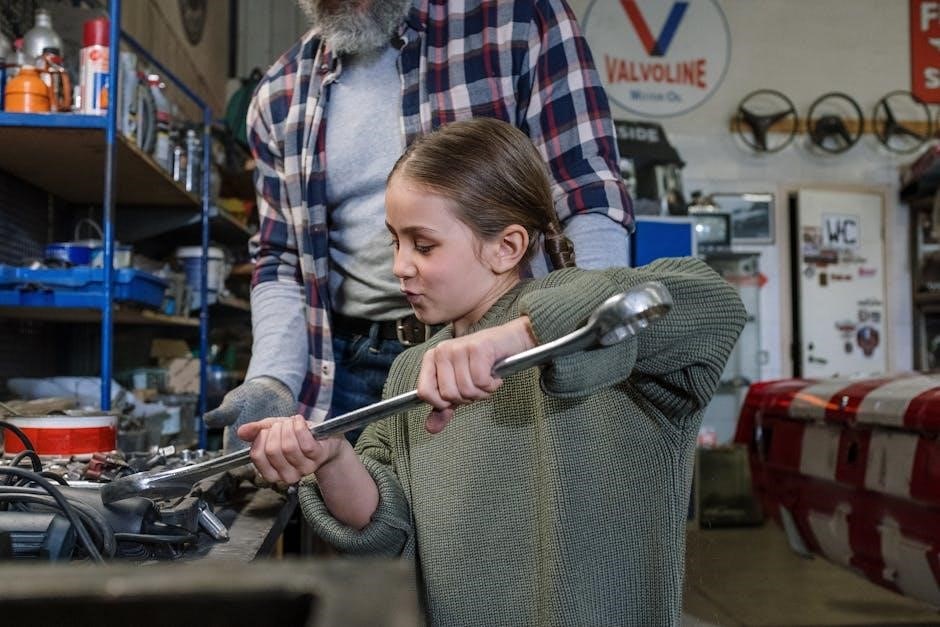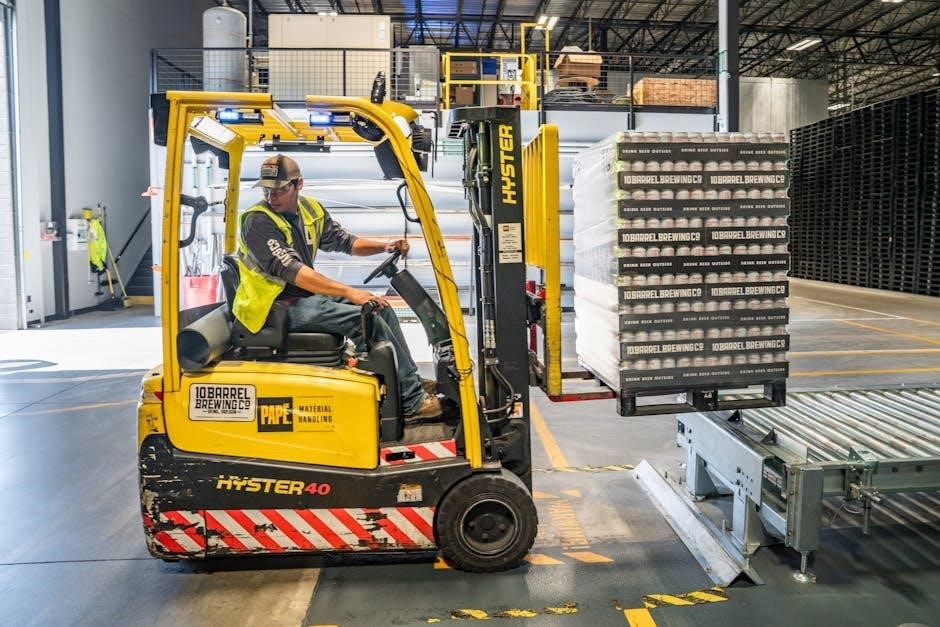Hyster forklift maintenance is essential for ensuring safety, efficiency, and longevity. Regular servicing, detailed in manuals, involves daily inspections, fluid checks, and scheduled part replacements to prevent downtime.
1.1 Overview of Hyster Forklifts
Hyster forklifts are renowned for their durability and versatility, catering to various industrial needs. Models like the A Series, H30E, and H135FT offer diverse capabilities, from heavy-duty lifting to compact maneuverability. These trucks are designed with advanced features, including robust hydraulic systems, reliable electrical components, and ergonomic operator interfaces. Whether powered by diesel, electric, or propane, Hyster forklifts are engineered to handle demanding environments. Their specifications, such as lifting capacities, tire configurations, and fuel options, are detailed in service manuals, ensuring optimal performance and maintenance. With a wide range of models, Hyster forklifts are adaptable to warehouses, construction sites, and other industrial settings, making them a trusted choice for material handling operations.
1.2 Importance of Regular Maintenance
Regular maintenance is critical for Hyster forklifts to ensure operational efficiency, safety, and longevity. Neglecting routine checks can lead to premature wear, costly repairs, and potential accidents. By adhering to the maintenance schedules outlined in service manuals, operators can identify and address issues early, minimizing downtime. Proper maintenance also enhances performance, ensuring that components like hydraulic systems, brakes, and tires function optimally. Additionally, regular servicing contributes to compliance with safety standards and reduces the risk of equipment failure. Investing time and resources in maintenance ultimately saves money and ensures the forklift operates reliably over its lifespan. Consistent upkeep is vital for preserving the value and functionality of Hyster forklifts in demanding industrial environments;

Safety Guidelines for Maintenance
Adhering to safety guidelines is crucial when maintaining Hyster forklifts. Always wear PPE, follow proper lockout procedures, and handle hazardous materials carefully to protect operators and equipment.

2.1 General Safety Practices
General safety practices are essential for ensuring a safe working environment when performing maintenance on Hyster forklifts. Always park the forklift on a level surface and engage the parking brake before starting any maintenance. Use jack stands to support the lift truck and ensure it is stable. Proper ventilation is crucial, especially when working with batteries or hazardous materials. Avoid wearing loose clothing or jewelry that could get caught in moving parts. Use tools and equipment appropriate for the task to prevent damage or injury. Familiarize yourself with emergency procedures, such as fire extinguisher locations and first aid kits. Always follow the manufacturer’s instructions and guidelines outlined in the Hyster service manual. Compliance with safety standards, such as those set by OSHA, is mandatory to minimize risks during maintenance operations.
2.2 Personal Protective Equipment (PPE)
Personal Protective Equipment (PPE) is critical for safeguarding technicians during Hyster forklift maintenance. Essential PPE includes safety glasses or goggles to protect eyes from debris, and gloves to prevent cuts and abrasions. A high-visibility vest ensures visibility in low-light environments. Steel-toe boots or safety shoes are mandatory to prevent foot injuries from heavy tools or equipment. Additionally, a respirator or dust mask may be required when handling hazardous materials or working in dusty conditions. Properly fitted hard hats should be worn if there is a risk of falling objects. Always ensure PPE is in good condition and meets workplace safety standards. Adherence to PPE requirements minimizes the risk of injury and ensures compliance with safety regulations during maintenance tasks.
2.3 Handling Hazardous Materials
When performing maintenance on Hyster forklifts, handling hazardous materials such as batteries, fuels, and hydraulic fluids requires careful attention. Always identify materials using Safety Data Sheets (SDS) and ensure proper labeling. Wear appropriate PPE, including gloves and goggles, to prevent skin and eye contact. Store hazardous materials in well-ventilated, designated areas away from ignition sources. Follow local regulations for disposal, as improper handling can lead to environmental contamination. In case of spills, use absorbent materials and neutralizing agents specified in the SDS. Keep emergency response equipment, such as fire extinguishers and spill kits, readily available. Train personnel on handling procedures and emergency protocols to minimize risks. Proper documentation of hazardous material storage and disposal is essential for compliance with safety and environmental standards.

Routine Maintenance Schedule
A well-structured routine maintenance schedule ensures Hyster forklifts operate efficiently and safely; Regular checks, including daily, weekly, and monthly tasks, help prevent breakdowns and extend equipment lifespan.
3.1 Daily Maintenance Checks
Daily maintenance checks are crucial for ensuring the optimal performance and safety of Hyster forklifts. Operators should begin with a visual inspection, checking for damage or wear on components like tires, forks, and chains. Fluid levels, including hydraulic, engine oil, and coolant, must be verified to meet manufacturer specifications. Tires should be inspected for proper inflation and signs of wear. Brake systems should be tested to ensure proper function. Additionally, operators should check the condition of the battery terminals and ensure all lights and alarms are functioning correctly. A thorough inspection of the lifting mechanism and hydraulic hoses for leaks or damage is also essential. Operators should consult the official Hyster forklift maintenance manual for specific guidelines tailored to their model. Consistent daily checks help prevent unexpected downtime and maintain operational efficiency.
3.1.1 Checking Fluid Levels

Checking fluid levels is a fundamental part of daily maintenance for Hyster forklifts. Operators should start by ensuring the forklift is on level ground and the engine is turned off. Hydraulic fluid, engine oil, coolant, and transmission fluid levels must be inspected using the dipsticks or sight gauges provided. Refer to the Hyster forklift maintenance manual for specific locations and procedures. Hydraulic fluid levels are critical for lift functionality, while engine oil lubricates moving parts. Coolant levels prevent overheating, and transmission fluid ensures smooth operation. If any fluid level is low, it should be replenished with the recommended type and viscosity. Leaks or unusual fluid colors may indicate issues requiring immediate attention. Always clean the dipstick before reinserting it for accurate readings. Record fluid levels in a maintenance log and address discrepancies promptly to avoid equipment damage.
3.1.2 Inspecting Tires and Wheels
Inspecting tires and wheels is essential for ensuring the stability and safety of Hyster forklifts. Begin by checking the tread depth to ensure it meets safety standards. Look for signs of uneven wear, such as bald spots or excessive wear on one side, which may indicate alignment issues. Check for cuts, punctures, or cracks in the tire sidewalls. Verify that all tires are inflated to the recommended pressure, as specified in the Hyster forklift maintenance manual. Inspect the wheels and rims for damage, rust, or debris. Ensure all nuts and bolts are tightened to the correct torque specifications. Additionally, check for loose or missing hubcaps, as they can lead to debris accumulation. Document any damage or wear and address them promptly to prevent accidents and maintain optimal performance.

3.1.3 Testing Brake Systems
Testing brake systems is a critical part of daily maintenance for Hyster forklifts. Begin by ensuring the forklift is on level ground and in neutral gear. Apply the parking brake and check for any leaks in the brake fluid reservoir. Inspect the brake pads, shoes, and drums for wear or damage, ensuring they meet minimum thickness specifications. Test the service brakes by slowly moving the forklift and applying the brakes firmly. Check for any unusual noises, vibrations, or soft pedal feel, which may indicate issues. Also, test the parking brake’s holding power on an incline. Use diagnostic tools to monitor brake system performance if equipped. Document any abnormalities and address them promptly to ensure safe operation and compliance with safety standards. Regular brake testing helps prevent accidents and extends the lifespan of the braking components.

3.2 Weekly Maintenance Tasks
Weekly maintenance tasks for Hyster forklifts are essential for ensuring optimal performance and longevity. Begin with a thorough battery inspection, checking charge levels, terminals, and connections for corrosion or damage. Ensure the battery water levels are adequate, and top up as needed using distilled water. Next, inspect the hydraulic system for any signs of leakage or damage, and verify fluid levels. Check the hydraulic oil for contamination or degradation and replace it if necessary. Additionally, examine the condition of tires and wheels, ensuring proper inflation and looking for wear or damage. Lubricate moving parts such as hinges, pivots, and chains according to the manufacturer’s recommendations. Finally, review the forklift’s operation performance and address any unusual behaviors or noises. Regular weekly maintenance helps identify potential issues early, reducing downtime and extending equipment life.
3.2.1 Battery Inspection and Maintenance
Weekly battery inspection and maintenance are critical for ensuring reliable performance and extending the lifespan of your Hyster forklift’s battery. Begin by checking the terminals and connections for cleanliness and tightness, as loose or corroded connections can disrupt power supply. Use a wire brush to clean any corrosion and ensure terminals are secure. Next, inspect the electrolyte levels, adding distilled water if necessary to maintain the recommended level. Avoid overfilling, as this can cause damage. Check the battery casing for cracks or damage and ensure all vents are clear. Measure the battery’s charge level and recharge it if necessary, following the manufacturer’s charging guidelines. Finally, monitor the battery’s overall health and performance, replacing it if signs of degradation or failure are evident. Proper battery care ensures consistent power delivery and prevents operational disruptions.

3.2.2 Hydraulic System Check
During the weekly hydraulic system check, inspect for leaks around hoses, fittings, and cylinders. Tighten any loose connections immediately to prevent fluid loss. Check the hydraulic fluid level using the dipstick, ensuring it meets the recommended level. Inspect the fluid’s condition; if it appears dirty or contaminated, schedule a filter change or fluid replacement. Examine hydraulic lines and hoses for signs of wear, cracks, or abrasion, and replace them if damaged. Test the hydraulic system by operating the forklift’s functions under load to ensure smooth operation. Check for any unusual noises or vibrations, which could indicate internal component wear. Inspect hydraulic filters for cleanliness and replace them as per the manufacturer’s schedule. Proper hydraulic system maintenance ensures optimal performance, prevents downtime, and extends the lifespan of hydraulic components. Always refer to the service manual for specific guidelines and procedures.
3.3 Monthly Maintenance Procedures
Monthly maintenance is crucial for ensuring the longevity and efficiency of your Hyster forklift. Begin with a thorough inspection of the overall condition of the forklift, checking for any visible damage or wear. Clean the forklift, paying attention to areas that accumulate dust or debris, such as the overhead guard and hydraulic components. Inspect and clean or replace air filters as needed to ensure proper airflow and engine performance. Lubricate all moving parts, including pivot points and gears, to reduce friction and prevent premature wear. Check the condition of belts and hoses, replacing them if signs of cracking or wear are present. Finally, test all operational functions under load to ensure everything is working smoothly. Regular monthly maintenance helps prevent unexpected breakdowns and keeps the forklift operating at peak performance. Always follow the manufacturer’s guidelines for specific procedures.
3.3.1 Replacing Air Filters
Replacing air filters is a critical monthly maintenance task for Hyster forklifts to ensure optimal engine performance and prevent dust or debris from entering the system. Start by shutting off the engine and allowing it to cool. Locate the air filter housing, typically found in the engine compartment, and release the clips or screws securing it. Carefully pull out the old filter and inspect it for excessive dirt or damage. Install a new genuine Hyster air filter, ensuring it is properly seated and aligned. Replace the housing and secure it tightly. Turn the key to the “on” position to test for any air leaks around the filter. Regular air filter replacement improves airflow, reduces fuel consumption, and extends engine life. Always refer to your Hyster service manual for specific instructions and recommendations.
3.3.2 Lubricating Moving Parts
Lubricating moving parts is essential for maintaining the smooth operation and longevity of your Hyster forklift. This monthly task should focus on components like hydraulic cylinders, tilt mechanisms, and pivot pins. Always use the lubricants recommended in the Hyster service manual, as they are specifically designed for the equipment’s needs. Before applying lubricant, clean the surfaces to remove dirt or debris. Apply the appropriate amount without over-lubricating, as excess can attract contaminants. Pay particular attention to high-wear areas, such as the mast and lift chains. Proper lubrication reduces friction, prevents corrosion, and ensures precise movement. Regularly check for worn or damaged parts that may require additional attention. Keep a record of lubrication schedules to stay on track and avoid overdue maintenance. Consult the manual for detailed instructions and lubricant specifications to ensure optimal results.
Troubleshooting Common Issues
Troubleshooting common issues in Hyster forklifts involves identifying faults, diagnosing root causes, and applying corrective actions. Always refer to the service manual for specific guidance and procedures.
4.1 Identifying Common Faults
Identifying common faults in Hyster forklifts is crucial for maintaining operational efficiency and safety. Common issues include hydraulic leaks, battery malfunctions, and brake system faults. Operators should look for signs like fluid drops, slow lifting, or unusual noises. Electrical system malfunctions, such as faulty sensors or wiring, can also occur. Tire wear, uneven lifting, or erratic movements may indicate problems with the lifting mechanism or stabilizers. Regular inspection of these components helps in early detection of faults. Ignoring these issues can lead to downtime, safety hazards, or costly repairs. Always consult the service manual for detailed diagnostic procedures. Keeping a maintenance log can help track recurring faults and prevent future breakdowns. Early identification ensures timely resolution and minimizes operational disruptions.
4.2 Using Diagnostic Tools and Techniques
Diagnosing issues in Hyster forklifts requires the use of specialized tools and techniques to ensure accuracy and efficiency. Operators and technicians often rely on diagnostic software provided by Hyster, which connects to the forklift’s control system to identify faults. Multimeters, pressure gauges, and hydraulic test kits are essential for measuring electrical and fluid systems; Visual inspections and listening for unusual noises can also help pinpoint problems. Troubleshooting checklists from the maintenance manual guide technicians through systematic evaluations. Error codes displayed on the control panel provide direct insights into system malfunctions. Regular training on these tools and techniques ensures that maintenance personnel can quickly and effectively identify and address issues. Proper use of diagnostic tools minimizes downtime and ensures repairs are done correctly. Always refer to the official service manual for detailed procedures and guidelines. Accurate diagnostics are critical for maintaining equipment performance and safety.

Major Repair and Overhaul
Major repairs involve replacing or rebuilding critical components like engines, transmissions, or hydraulic systems. Specialized tools and adherence to the service manual are essential for success. Proper overhaul ensures longevity and reliability, while following manufacturer guidelines prevents future issues. Always prioritize safety and precision during major repairs to maintain equipment performance and operator safety. Regular overhauls are vital for extending the lifespan of Hyster forklifts. Detailed procedures in the manual guide technicians through complex tasks. Proper documentation of repairs ensures accountability and traceability. Major repairs require a skilled workforce and quality replacement parts. Timely overhauls prevent unexpected breakdowns and reduce operational downtime. Safety protocols must be strictly followed during major repair operations. Thorough testing post-repair ensures systems function optimally. Major repairs are a significant investment in maintaining fleet efficiency and productivity. Regular maintenance helps minimize the need for major overhauls. Always use genuine Hyster parts for optimal performance and durability. Proper storage of repaired components prevents damage. Major repair facilities should be well-equipped to handle heavy machinery. Technician training is crucial for mastering complex repair procedures. Major repairs should only be performed by authorized personnel. Detailed records of repairs aid in future maintenance planning; Major overhauls are a critical part of extending the service life of Hyster forklifts. Proper waste disposal of replaced parts is environmentally responsible. Major repairs require careful planning and scheduling to minimize operational impact. Regular inspections help identify the need for major repairs before failures occur. Major overhaul procedures are fully detailed in the official service manual. Adhering to torque specifications and alignment guidelines ensures reliability. Major repairs are a testament to the durability and longevity of Hyster forklifts. Proper cleaning and lubrication of repaired components prevent premature wear. Major repairs should be complemented with thorough functional testing. Investing in major repairs ensures the continued safety and efficiency of Hyster forklifts. Regularly updated service manuals reflect the latest repair techniques and recommendations. Major repairs are a key aspect of maintaining a productive and safe fleet of Hyster forklifts. Properly documented repairs provide a clear history for future reference. Major repairs require collaboration between experienced technicians and state-of-the-art facilities. Always prioritize quality and precision during major repair and overhaul processes. Major repairs are essential for maintaining the performance and reliability of Hyster forklifts. Regular overhauls contribute to operational efficiency and cost savings in the long run. Major repairs should only be entrusted to certified professionals with extensive experience. Properly executed major repairs ensure the forklift operates at its full potential. Major repair and overhaul are critical for maintaining the integrity of Hyster forklifts. Detailed repair procedures in the manual ensure consistency and accuracy. Major repairs are a significant step in preserving the value of Hyster equipment. Properly performed overhauls enhance the overall performance and safety of the forklift. Major repairs and overhauls are essential for extending the operational life of Hyster forklifts. Regular major repairs minimize the risk of sudden equipment failure. Always refer to the official service manual for guidance during major repairs. Major repairs and overhauls are vital for maintaining a reliable and efficient fleet. Properly trained technicians are essential for executing major repairs successfully. Major repairs ensure Hyster forklifts continue to meet safety and performance standards. Regular overhauls help prevent costly breakdowns and extend equipment lifespan. Major repairs are a crucial part of proactive maintenance strategies. Proper documentation of major repairs aids in tracking maintenance history. Major repairs require a thorough understanding of Hyster forklift systems and components. Regular major repairs contribute to the overall efficiency of warehouse operations. Properly executed major repairs ensure compliance with safety regulations. Major repairs and overhauls are a key part of responsible fleet management. Always use genuine Hyster parts during major repairs for optimal performance. Regular major repairs help maintain the resale value of Hyster forklifts. Properly performed overhauls ensure the forklift operates safely and efficiently. Major repairs are an investment in the longevity and reliability of Hyster equipment. Regular major repairs minimize downtime and enhance operational productivity. Properly documented major repairs provide valuable insights for future maintenance. Major repairs and overhauls are essential for maintaining the performance of Hyster forklifts. Regular major repairs ensure the forklift remains in optimal working condition. Properly trained technicians are indispensable for executing major repairs effectively. Major repairs are a critical component of a comprehensive maintenance program. Regular overhauls help maintain the safety and efficiency of Hyster forklifts. Properly performed major repairs ensure the forklift continues to meet operational demands. Major repairs are a vital aspect of responsible equipment ownership. Regular major repairs contribute to the overall success of material handling operations. Properly documented major repairs ensure accountability and traceability. Major repairs and overhauls are essential for extending the service life of Hyster forklifts. Regular major repairs help prevent unexpected breakdowns and reduce downtime. Properly executed major repairs ensure the forklift operates at peak performance. Major repairs are a key part of maintaining a safe and efficient fleet. Regular major repairs ensure compliance with industry safety standards. Properly performed overhauls enhance the reliability and longevity of Hyster forklifts. Major repairs require careful planning and execution to ensure optimal results. Regular major repairs are a testament to the durability of Hyster equipment. Properly documented major repairs provide a clear maintenance history. Major repairs and overhauls are essential for maintaining the integrity of Hyster forklifts. Regular major repairs ensure the forklift continues to perform at its best. Properly trained technicians are crucial for successfully completing major repairs. Major repairs are an essential part of proactive fleet maintenance strategies. Regular major repairs help maintain the operational efficiency of Hyster forklifts. Properly executed overhauls ensure the forklift remains safe and reliable. Major repairs are a critical investment in the longevity of Hyster equipment. Regular major repairs minimize the risk of costly breakdowns. Properly documented major repairs aid in future maintenance planning. Major repairs and overhauls are vital for maintaining the performance of Hyster forklifts. Regular major repairs ensure the forklift operates safely and efficiently; Properly trained technicians are essential for performing major repairs correctly. Major repairs are a key component of responsible equipment maintenance. Regular major repairs contribute to the overall success of warehouse operations. Properly performed overhauls ensure the forklift continues to meet operational demands. Major repairs are an essential part of maintaining a reliable fleet. Regular major repairs help extend the lifespan of Hyster forklifts. Properly documented major repairs provide valuable insights for future reference. Major repairs and overhauls are critical for maintaining the integrity of Hyster equipment. Regular major repairs ensure the forklift remains in optimal working condition. Properly trained technicians are indispensable for executing major repairs effectively. Major repairs are a vital part of proactive maintenance strategies. Regular major repairs minimize downtime and enhance operational efficiency. Properly performed overhauls ensure the forklift operates at its full potential. Major repairs are an investment in the longevity and reliability of Hyster forklifts. Regular major repairs help maintain the safety and performance of the equipment. Properly documented major repairs ensure accountability and traceability. Major repairs and overhauls are essential for extending the service life of Hyster forklifts. Regular major repairs contribute to the overall success of material handling operations. Properly trained technicians are crucial for successfully completing major repairs. Major repairs are a key part of maintaining a safe and efficient fleet. Regular major repairs ensure the forklift continues to perform at its best. Properly executed overhauls enhance the reliability and longevity of Hyster forklifts. Major repairs require careful planning and execution to ensure optimal results. Regular major repairs help prevent unexpected breakdowns and reduce downtime. Properly performed major repairs ensure the forklift operates safely and efficiently. Major repairs are a critical component of a comprehensive maintenance program. Regular major repairs ensure compliance with industry safety standards. Properly documented major repairs provide a clear maintenance history. Major repairs and overhauls are essential for maintaining the performance of Hyster forklifts. Regular major repairs minimize the risk of costly breakdowns. Properly trained technicians are essential for performing major repairs correctly. Major repairs are an essential part of proactive fleet maintenance strategies. Regular major repairs help maintain the operational efficiency of Hyster forklifts. Properly performed overhauls ensure the forklift remains safe and reliable. Major repairs are a key investment in the longevity of Hyster equipment. Regular major repairs contribute to the overall efficiency of warehouse operations. Properly documented major repairs aid in future maintenance planning. Major repairs and overhauls
5.1 Hydraulic System Repairs
The hydraulic system is a critical component of Hyster forklifts, powering essential functions like lifting and steering. Repairs often involve addressing fluid leaks, faulty pumps, or damaged cylinders. Technicians must relieve hydraulic pressure before starting work to ensure safety. Inspecting hoses, seals, and valves for wear or damage is crucial. Replacing worn or corroded parts with genuine Hyster components ensures optimal performance. Hydraulic fluid levels and cleanliness should be checked to prevent system contamination. Using specialized tools, such as hydraulic test equipment, helps diagnose and resolve issues efficiently. Proper alignment and torque specifications must be followed during reassembly. Regular maintenance, like filter replacements, can prevent hydraulic system failures. Always refer to the official service manual for detailed repair procedures. Proper disposal of hazardous materials, like hydraulic fluid, is environmentally responsible. Regular inspections and timely repairs extend the lifespan of the hydraulic system. Technician training is essential for mastering hydraulic repairs. Adhering to safety protocols prevents accidents during hydraulic system repairs. Genuine parts ensure reliability and longevity of the hydraulic system. Detailed documentation of repairs aids in future maintenance planning. Properly executed hydraulic repairs restore the forklift’s operational efficiency and safety. Regular maintenance minimizes the risk of hydraulic system failures. Timely repairs prevent costly downtime and extend equipment lifespan. Hydraulic system repairs require precision and adherence to manufacturer guidelines. Properly trained technicians are indispensable for complex hydraulic repairs. Regular inspections help identify potential issues before they escalate. Hydraulic system repairs are a key part of maintaining Hyster forklift performance. Properly performed repairs ensure the hydraulic system functions safely and efficiently. Regular maintenance and repairs extend the service life of the hydraulic system. Technicians must follow the service manual for accurate repair procedures. Hydraulic system repairs are essential for maintaining fleet productivity and safety. Properly documented repairs provide a clear history for future reference. Regular inspections and timely repairs minimize hydraulic system downtime. Genuine parts ensure the hydraulic system operates at peak performance. Hydraulic system repairs require careful planning and execution. Properly trained technicians are crucial for successful hydraulic repairs. Regular maintenance ensures the hydraulic system remains reliable and efficient. Hydraulic system repairs are a vital part of proactive forklift maintenance. Properly performed repairs prevent unexpected failures and enhance operational safety. Regular inspections help identify wear and tear before major issues arise. Hydraulic system repairs are essential for maintaining the integrity of Hyster forklifts. Properly documented repairs ensure accountability and traceability. Regular maintenance and repairs extend the lifespan of the hydraulic system. Technicians must adhere to safety protocols during hydraulic repairs. Hydraulic system repairs require specialized tools and expertise. Properly trained technicians are essential for mastering hydraulic repair techniques. Regular inspections and timely repairs ensure the hydraulic system operates smoothly. Hydraulic system repairs are a key part of responsible fleet management. Properly performed repairs restore the forklift’s hydraulic system to optimal condition. Regular maintenance minimizes the risk of hydraulic system breakdowns. Hydraulic system repairs are a critical investment in equipment longevity. Properly documented repairs provide valuable insights for future maintenance. Hydraulic system repairs are essential for maintaining the performance of Hyster forklifts. Regular inspections help identify potential issues early. Properly trained technicians are indispensable for complex hydraulic repairs. Hydraulic system repairs require precision and adherence to guidelines. Properly executed repairs ensure the hydraulic system functions safely and efficiently. Regular maintenance extends the service life of the hydraulic system. Hydraulic system repairs are a key part of proactive maintenance strategies. Properly documented repairs aid in future planning and accountability. Regular inspections and timely repairs minimize hydraulic system downtime. Hydraulic system repairs are essential for maintaining operational efficiency and safety. Properly trained technicians are crucial for successful repairs. Hydraulic system repairs require careful planning and specialized tools. Properly performed repairs ensure the hydraulic system operates at peak performance. Regular maintenance and repairs extend the lifespan of the hydraulic system. Hydraulic system repairs are a vital part of responsible equipment ownership. Properly documented repairs ensure a clear maintenance history. Regular inspections help identify wear and tear before major issues arise. Hydraulic system repairs are essential for maintaining the integrity of Hyster forklifts. Properly trained technicians are essential for mastering hydraulic repair techniques. Hydraulic system repairs require adherence to safety protocols and manufacturer guidelines. Properly performed repairs restore the hydraulic system to optimal functionality. Regular maintenance ensures the hydraulic system remains reliable and efficient. Hydraulic system repairs are a key part of maintaining fleet productivity and safety. Properly documented repairs provide accountability and traceability. Regular inspections and timely repairs minimize hydraulic system breakdowns. Hydraulic system repairs are essential for maintaining the performance of Hyster forklifts. Properly trained technicians are indispensable for complex hydraulic repairs. Hydraulic system repairs require precision and specialized tools. Properly executed repairs ensure the hydraulic system functions safely and efficiently. Regular maintenance extends the service life of the hydraulic system. Hydraulic system repairs are a key part of proactive fleet maintenance. Properly documented repairs aid in future maintenance planning. Regular inspections help identify potential issues early. Hydraulic system repairs are essential for maintaining operational efficiency and safety. Properly trained technicians are crucial for successful repairs. Hydraulic system repairs require careful planning and execution. Properly performed repairs ensure the hydraulic system operates at peak performance. Regular maintenance and repairs extend the lifespan of the hydraulic system. Hydraulic system repairs are a vital part of responsible equipment management. Properly documented repairs ensure a clear maintenance history. Regular inspections help identify wear and tear before major issues arise. Hydraulic system repairs are essential for maintaining the integrity of Hyster forklifts. Properly trained technicians are essential for mastering hydraulic repair techniques. Hydraulic system repairs require adherence to safety protocols and guidelines. Properly performed repairs restore the hydraulic system to optimal functionality. Regular maintenance ensures the hydraulic system remains reliable and efficient. Hydraulic system repairs are a key part of maintaining fleet productivity and safety. Properly documented repairs provide accountability and traceability. Regular inspections and timely repairs minimize hydraulic system downtime. Hydraulic system repairs are essential for maintaining the performance of Hyster forklifts. Properly trained technicians are indispensable for complex hydraulic repairs. Hydraulic system repairs require precision and specialized tools. Properly executed repairs ensure the hydraulic system functions safely and efficiently. Regular maintenance extends the service life of the hydraulic system. Hydraulic system repairs are a key part of proactive maintenance strategies. Properly documented repairs aid in future planning and accountability. Regular inspections help identify potential issues early. Hydraulic system repairs are essential for maintaining operational efficiency and safety. Properly trained technicians are crucial for successful repairs. Hydraulic system repairs require careful planning and execution. Properly performed repairs ensure the hydraulic system operates at peak performance. Regular maintenance and repairs extend the lifespan of the hydraulic system. Hydraulic system repairs are a vital part of responsible equipment ownership. Properly documented repairs ensure a clear maintenance history. Regular inspections help identify wear and tear before major issues arise. Hydraulic system repairs are essential for maintaining the integrity of Hyster forklifts. Properly trained technicians are essential for mastering hydraulic repair techniques. Hydraulic system repairs require adherence to safety protocols and manufacturer guidelines. Properly performed repairs restore the hydraulic system to optimal functionality. Regular maintenance ensures the hydraulic system remains reliable and efficient. Hydraulic system repairs are a key part of maintaining fleet productivity and safety. Properly documented repairs provide accountability and traceability. Regular inspections and timely repairs minimize hydraulic system breakdowns. Hydraulic system repairs are essential for maintaining the performance of Hyster forklifts. Properly trained technicians are indispensable for complex hydraulic repairs. Hydraulic system repairs require precision and specialized tools. Properly executed repairs ensure the hydraulic system functions safely and efficiently. Regular maintenance extends the service life of the hydraulic system. Hydraulic system repairs are a key part of proactive fleet maintenance. Properly documented repairs aid in future maintenance planning. Regular inspections help identify potential issues early. Hydraulic system repairs are essential for maintaining operational efficiency and safety. Properly trained technicians are crucial for successful repairs. Hydraulic system repairs require careful planning and execution. Properly performed repairs ensure the hydraulic system operates at peak performance. Regular maintenance and repairs extend the lifespan of the hydraulic system. Hydraulic system repairs are a vital part of responsible equipment management. Properly documented repairs ensure a clear maintenance history. Regular inspections help identify wear and tear before major issues arise. Hydraulic system repairs are essential for maintaining the integrity of Hyster forklifts. Properly trained technicians are essential for mastering hydraulic repair techniques. Hydraulic system repairs require adherence to safety protocols and guidelines. Properly performed repairs restore the hydraulic system to optimal functionality. Regular maintenance

Additional Resources and Support
5.2 Electrical System Troubleshooting
Troubleshooting the electrical system of a Hyster forklift involves identifying and resolving issues with wiring, circuits, and components. Common problems include blown fuses, faulty sensors, or malfunctioning control modules. Always disconnect the battery before starting repairs to ensure safety. Use a multimeter to test voltage, resistance, and continuity in electrical circuits. Check for short circuits, open connections, or corroded terminals, which can disrupt power flow. Replace damaged wiring or components with genuine Hyster parts to maintain system integrity. Consult the service manual for wiring diagrams and troubleshooting guides specific to your model. Addressing electrical issues promptly prevents downtime and ensures safe operation. Proper tools and knowledge are essential for accurate diagnostics. Regular inspections can help identify potential electrical problems before they escalate. Always follow safety protocols when working with electrical systems to avoid injury or further damage. Proper documentation of repairs aids in future maintenance planning.